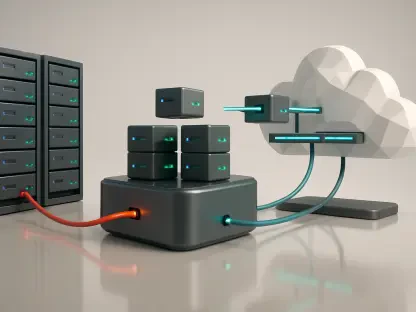In an era where network efficiency and scalability are paramount for businesses navigating the complexities of digital transformation, the Zero-Touch Provisioning (ZTP) market emerges as a game-changer with remarkable growth potential. This technology, which enables automated network deployment and configuration with minimal human intervention, is witnessing a surge as organizations strive to eliminate manual errors and streamline operations. Valued at $3.5 billion in 2024, the global ZTP market is on a trajectory to hit $8.1 billion by 2032, reflecting a robust compound annual growth rate (CAGR) of 11.11% over the next several years. This surge is fueled by the escalating demand for automation amid rapid advancements in cloud computing, 5G infrastructure, and the Internet of Things (IoT). As enterprises and telecom providers grapple with increasingly intricate network environments, ZTP stands out as a vital solution to ensure seamless deployment and management, paving the way for a more connected and efficient digital landscape.
Driving Forces Behind Market Expansion
The momentum behind the ZTP market is largely driven by the pressing need for automation in network management to enhance efficiency and reduce human error. With digital transformation accelerating across industries, businesses are adopting sophisticated technologies that require agile and error-free network setups. The rise of cloud services and the rollout of 5G networks are significant catalysts, as they demand rapid provisioning to meet modern connectivity standards. Additionally, the proliferation of IoT devices adds another layer of complexity, pushing organizations to seek solutions that can handle large-scale deployments effortlessly. In the U.S. alone, the market is expected to grow from its substantial base to $1,337.7 million by 2030, with a steady CAGR of 9.3%, highlighting the region’s leadership in adopting cutting-edge network solutions. This growth underscores a broader trend where manual processes are becoming obsolete in the face of dynamic, technology-driven environments.
Another critical factor propelling the ZTP market forward is the convergence of next-generation technologies that necessitate innovative provisioning approaches. The integration of 5G infrastructure, for instance, requires networks to be deployed at unprecedented speeds to support high-bandwidth applications and low-latency connections. Meanwhile, the expansion of IoT ecosystems in smart infrastructure and edge computing is creating a surge in connected devices that must be managed efficiently. ZTP solutions address these challenges by offering automated configuration and deployment, ensuring that networks can scale rapidly without compromising reliability. Beyond technological drivers, the economic benefits of reducing operational downtime and labor costs further incentivize adoption. As enterprises prioritize agility to remain competitive, the demand for automated provisioning tools is set to intensify, positioning ZTP as a cornerstone of modern network strategies.
Market Segmentation and Growth Trends
Breaking down the ZTP market by components reveals distinct trends shaping its trajectory. In 2024, the platform segment dominated with a commanding 75% market share, thanks to its scalability and compatibility with diverse vendor systems. These platforms provide centralized management capabilities, making them indispensable for enterprises handling complex infrastructures. However, the services segment is projected to experience the fastest growth over the forecast period, driven by the increasing intricacy of network deployments. As businesses encounter challenges in integrating new technologies, the need for specialized support and expertise becomes paramount. This shift highlights a growing reliance on tailored services to navigate the evolving landscape of network management, ensuring that organizations can fully leverage the benefits of automation while addressing unique operational needs.
When examining device types within the ZTP market, switches held the largest revenue share in 2024, given their pivotal role in backbone and data center networks connecting multi-vendor devices. Their importance in maintaining robust network connectivity makes them a focal point for automation solutions. On the other hand, the IoT devices segment is anticipated to grow at the fastest pace from now through 2032, spurred by the rise of smart infrastructure and edge computing applications. As more devices connect at the network edge, the demand for automated provisioning to manage these endpoints efficiently becomes critical. This trend reflects a broader shift toward decentralized network architectures, where agility and responsiveness are essential. The diversity in device types underscores the versatility of ZTP solutions, catering to both traditional network components and emerging technologies that are redefining connectivity standards.
Evolving Network Architectures and Future Outlook
In terms of network complexity, the complex network architecture segment led the market in 2024, driven by enterprise demand for sophisticated setups across data centers, cloud environments, and remote locations. These environments often involve intricate configurations that benefit immensely from automation, as manual management becomes impractical at scale. The ability of ZTP to simplify deployment in such settings has made it a preferred choice for large organizations aiming to optimize their infrastructure. This dominance reflects the growing reliance on advanced network solutions to support sprawling digital ecosystems, where downtime or errors can have significant repercussions. As businesses continue to expand their digital footprint, the role of ZTP in managing complexity remains indispensable, ensuring seamless operations across diverse environments.
Looking at dynamic network environments, this segment is poised to register the highest CAGR over the coming years, as enterprises increasingly adopt agile, cloud-native, and mobile-first architectures. These environments prioritize flexibility and rapid adaptation to changing demands, making automated provisioning a critical enabler. Unlike static or complex setups, dynamic networks require real-time adjustments to support fluctuating workloads and connectivity needs, a challenge that ZTP addresses effectively. The shift toward such architectures signals a broader industry movement toward responsiveness in a fast-paced digital world. As cloud adoption and mobility continue to redefine operational models, the reliance on ZTP to maintain network performance without manual intervention will grow. This trend points to a future where automation becomes not just a convenience but a necessity for staying competitive in an ever-evolving technological landscape.
Reflecting on Market Potential and Next Steps
Looking back, the journey of the ZTP market showcases a remarkable ascent, driven by an industry-wide pivot toward automation and efficiency. The convergence of 5G, IoT, and cloud computing has created fertile ground for ZTP solutions to flourish, addressing the urgent need for scalable and reliable network management. As the market evolved, segments like services and IoT devices emerged as key growth areas, signaling a shift toward specialized support and edge technologies. For stakeholders, the path forward involves investing in innovative ZTP platforms that can adapt to dynamic network demands while offering robust integration with emerging technologies. Exploring partnerships with service providers to deliver customized solutions also proves essential in meeting diverse enterprise needs. Ultimately, staying ahead requires a commitment to leveraging automation as a strategic asset, ensuring that networks remain agile and resilient in the face of future challenges.









